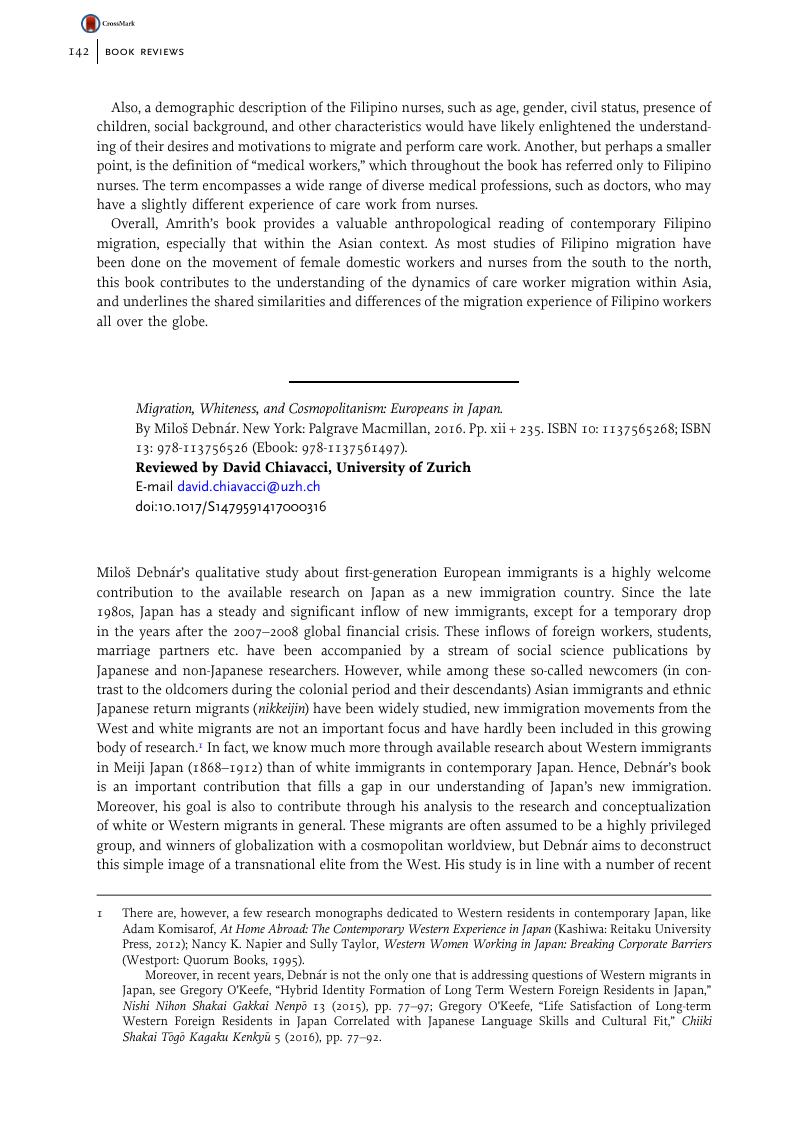No CrossRef data available.
Article contents
Migration, Whiteness, and Cosmopolitanism: Europeans in Japan. By Miloš Debnár . New York: Palgrave Macmillan, 2016. Pp. xii + 235. ISBN 10: 1137565268; ISBN 13: 978-113756526 (Ebook: 978-1137561497).
Published online by Cambridge University Press: 31 January 2018
Abstract

- Type
- Book Reviews
- Information
- Copyright
- Copyright © Cambridge University Press 2018
References
1 There are, however, a few research monographs dedicated to Western residents in contemporary Japan, like Komisarof, Adam, At Home Abroad: The Contemporary Western Experience in Japan (Kashiwa: Reitaku University Press, 2012)Google Scholar; Napier, Nancy K. and Taylor, Sully, Western Women Working in Japan: Breaking Corporate Barriers (Westport: Quorum Books, 1995)Google Scholar.
Moreover, in recent years, Debnár is not the only one that is addressing questions of Western migrants in Japan, see O'Keefe, Gregory, “Hybrid Identity Formation of Long Term Western Foreign Residents in Japan,” Nishi Nihon Shakai Gakkai Nenpō 13 (2015), pp. 77–97 Google Scholar; O'Keefe, Gregory, “Life Satisfaction of Long-term Western Foreign Residents in Japan Correlated with Japanese Language Skills and Cultural Fit,” Chiiki Shakai Tōgō Kagaku Kenkyū 5 (2016), pp. 77–92 Google Scholar.
2 See, for example, Lundström, Catrin, White Migrations: Gender, Whiteness and Privilege in Transnational Migration (London: Palgrave, 2014)Google Scholar; Maher, Kristen Hill and Lafferty, Megan, “White Migrant Masculinities in Thailand and the Paradoxes of Western Privilege,” Social & Cultural Geography 15:4 (2014), pp. 427–48CrossRefGoogle Scholar.
3 Wagatsuma, Hiroshi, “The Social Perception of Skin Color in Japan,” Daedalus 96:2 (1967), pp. 407–44Google Scholar.
4 See, for example, Russell, John G., “Replicating the White Self and Other: Skin Color, Racelessness, Gynoids, and the Construction of Whiteness in Japan,” Japanese Studies 37:1 (2017), pp. 23–48 CrossRefGoogle Scholar.




